
A horseshoe is a fabricated product designed to protect a horse hoof from wear. Shoes are attached on the palmar surface of the hooves, usually nailed through the insensitive hoof wall that is anatomically akin to the human toenail, although much larger and thicker. However, there are also cases where shoes are glued.
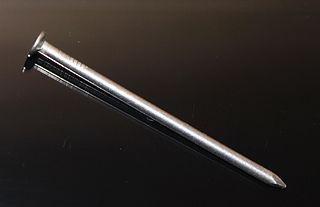
In woodworking and construction, a nail is a small object made of metal which is used as a fastener, as a peg to hang something, or sometimes as a decoration. Generally, nails have a sharp point on one end and a flattened head on the other, but headless nails are available. Nails are made in a great variety of forms for specialized purposes. The most common is a wire nail. Other types of nails include pins, tacks, brads, spikes, and cleats.
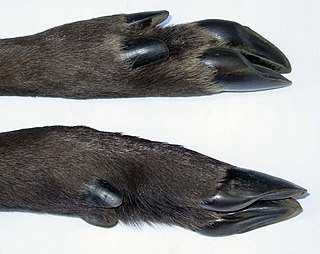
The hoof is the tip of a toe of an ungulate mammal, which is covered and strengthened with a thick and horny keratin covering. Artiodactyls are even-toed ungulates, species whose feet have an even number of digits, yet the ruminants with two digits, are the most numerous, e.g. giraffe, deer, bison, cattle, goat, and sheep. The feet of perissodactyl mammals have an odd number of toes, e.g. the horse, the rhinoceros, and the tapir. Hooves are limb structures restricted to placental mammals, which have long pregnancies; however, the marsupial Chaeropus had hooves.
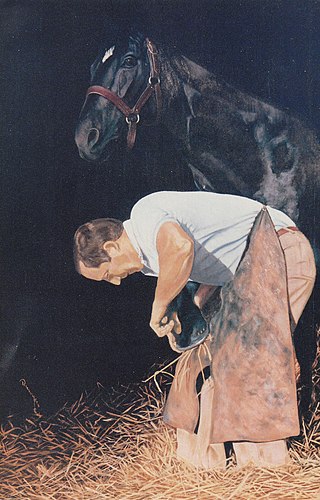
A farrier is a specialist in equine hoof care, including the trimming and balancing of horses' hooves and the placing of shoes on their hooves, if necessary. A farrier combines some blacksmith's skills with some veterinarian's skills to care for horses' feet. Traditionally an occupation for men, in a number of countries women have now become farriers.

Laminitis is a disease that affects the feet of ungulates and is found mostly in horses and cattle. Clinical signs include foot tenderness progressing to inability to walk, increased digital pulses, and increased temperature in the hooves. Severe cases with outwardly visible clinical signs are known by the colloquial term founder, and progression of the disease will lead to perforation of the coffin bone through the sole of the hoof or being unable to stand up, requiring euthanasia.
Navicular syndrome, often called navicular disease, is a syndrome of lameness problems in horses. It most commonly describes an inflammation or degeneration of the navicular bone and its surrounding tissues, usually on the front feet. It can lead to significant and even disabling lameness.
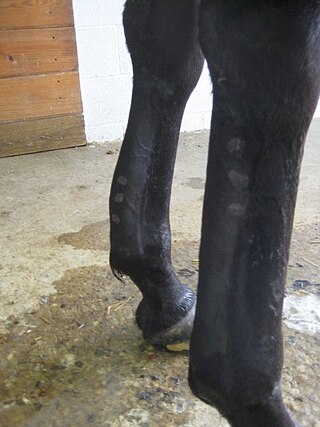
Tendinitis/tendonitis is inflammation of a tendon, often involving torn collagen fibers. A bowed tendon is a horseman's term for a tendon after a horse has sustained an injury that causes swelling in one or more tendons creating a "bowed" appearance.

There are many aspects to horse management. Horses, ponies, mules, donkeys and other domesticated equids require attention from humans for optimal health and long life.
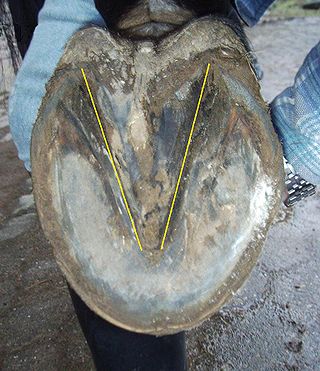
The frog is a part of a horse hoof, located on the underside, which should touch the ground if the horse is standing on soft footing. The frog is triangular in shape, and extends midway from the heels toward the toe, covering around 25% of the bottom of the hoof.
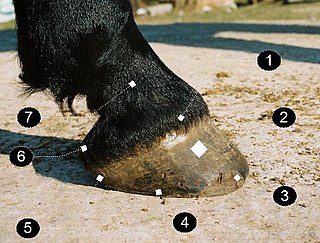
A horse hoof is the lower extremity of each leg of a horse, the part that makes contact with the ground and carries the weight of the animal. It is both hard and flexible. It is a complex structure surrounding the distal phalanx of the 3rd digit of each of the four limbs, which is covered by soft tissue and keratinised (cornified) matter.

A hoof boot is a device made primarily of polyurethane and is designed to cover the hooves of a horse as an alternative to, and occasionally in addition to, horseshoes. Hoof boots can also be used as a protective device when the animal has a hoof injury that requires protection of the sole of the hoof, or to aid in the application of medication. There are many different designs, but all have the goal of protecting the hoof wall and sole of the horse's hoof from hard surfaces, rocks and other difficult terrain.

In footwear, a hobnail is a short nail with a thick head used to increase the durability of boot soles.
Equine podiatry is the study and management of the equine foot based on its anatomy and function.

Nail prick or quicking occurs in a horse if the sensitive hoof structures are penetrated by a horseshoe nail being driven through the hoof wall while shoeing. The nail creates a wound on the inside of the hoof wall.

Natural hoof care is the practice of keeping horses so that their hooves are worn down naturally, or trimmed to emulate natural wear, so they do not suffer overgrowth, splitting and other disorders. Horseshoes are not used, but domesticated horses may still require trimming, exercise and other measures to maintain a natural shape and degree of wear.

The Horse Protection Act of 1970 (HPA); is a United States federal law, under which the practice of soring is a crime punishable by both civil and criminal penalties, including fines and jail time. It is illegal to show a horse, enter it at a horse show, or to auction, sell, offer for sale, or transport a horse for any of these purposes if it has been sored.
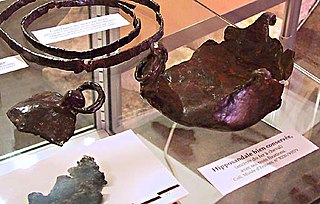
The hipposandal is a device that protected the hoof of a horse. It was commonplace in the northwestern countries of the Roman Empire, and was a predecessor to the horseshoe.
Soring, or "big lick", is defined as the application of any chemical, mechanical agent, or practice inflicted upon any limb of a horse, that can cause or be expected to cause the horse to suffer physical pain or distress when moving. This results in the horses picking up their front feet higher and faster than they would do in their natural gait. Trainers use soring to give a horse a highly animated gait in a short time period rather than spending time training them to perform this gait naturally. People who sore their horses believe that it gives them a competitive edge over other horses in the show ring. However, soring is illegal in the United States under the Horse Protection Act of 1970. Tennessee Walking Horses are not allowed to be shown without passing a USDA and HPA inspection for soring and physical inspection; they are not allowed to have scars on their pastern as it is associated with soring. Other breeds that have a history of soring including the Racking Horse and the Spotted Saddle Horse.

Simon John Curtis is a farrier, author, lecturer and horse hoof-care expert with a PhD in Equine Physiology and Biomechanics (2017). He is a 4th generation farrier; his family have been farriers and blacksmiths in the Newmarket area for at least 150 years. In over 45 years working as a farrier, he has lectured and demonstrated in more than 30 countries including the USA, Australia, India, Russia, and Brazil.



















